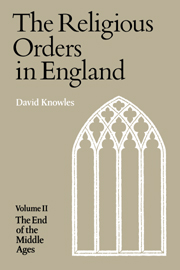Book contents
- Frontmatter
- Contents
- Preface
- List of Abbreviations
- Part One The Historical Framework
- Part Two The Institutional Background
- Chap. XVII Recruitment, employment and the horarium
- Chap. XVIII The wage-system and the common life
- Chap. XIX The election and privileges of the superior
- Chap. XX The numbers of the religious
- Chap. XXI Literary work
- Chap. XXII The monasteries and society
- Chap. XXIII Vicarages, the cure of souls and schools
- Chap. XXIV Public obligations of heads of houses
- Chap. XXV The monastic economy, 1320–1480
- Chap. XXVI Monastic Libraries
- Chap. XXVII Retrospect
- Appendix I Chaucer's monk
- Appendix II Henry V and the Westminster recluse
- Appendix III Regulars as bishops
- Bibliography
- Index
Chap. XVII - Recruitment, employment and the horarium
Published online by Cambridge University Press: 28 January 2010
- Frontmatter
- Contents
- Preface
- List of Abbreviations
- Part One The Historical Framework
- Part Two The Institutional Background
- Chap. XVII Recruitment, employment and the horarium
- Chap. XVIII The wage-system and the common life
- Chap. XIX The election and privileges of the superior
- Chap. XX The numbers of the religious
- Chap. XXI Literary work
- Chap. XXII The monasteries and society
- Chap. XXIII Vicarages, the cure of souls and schools
- Chap. XXIV Public obligations of heads of houses
- Chap. XXV The monastic economy, 1320–1480
- Chap. XXVI Monastic Libraries
- Chap. XXVII Retrospect
- Appendix I Chaucer's monk
- Appendix II Henry V and the Westminster recluse
- Appendix III Regulars as bishops
- Bibliography
- Index
Summary
Although biographical accounts and items of personal information are rare in the later medieval period, it is possible to arrive at a fairly clear estimate of the local origin, and at a less clear one of the social standing, of recruits to the monasteries of black monks. Detailed information about the Cistercians and the canons black and white is more scanty, but all indications tend to show that there was no great difference between them and the black monks in the provenance and class of their recruits.
From the end of the twelfth century it was common, and in the fourteenth and fifteenth centuries all but universal, for a monk to be known by his own Christian name specified by his place of origin: e.g. William of London. Only those of distinguished family, such as Thomas de la Mare, and, from the end of the fourteenth century onwards, a growing number of townsfolk, were known by a family surname, but even when, in the early sixteenth century, this custom was becoming more general, it vas still common for a monk to be known by his place of origin, as can be seen when, for example, the William of Boston who appears at a visitation figures as William Perkins in a pension list a few years later. As we possess complete lists of the monks of Christ Church, Canterbury, Westminster and Durham—three of the largest and most distinguished houses in the country—and numerous shorter lists and references to monks of many other houses, we can determine the provenance of a very large crosssection of the monastic population.
- Type
- Chapter
- Information
- Religious Orders Vol 2 , pp. 229 - 239Publisher: Cambridge University PressPrint publication year: 1979

